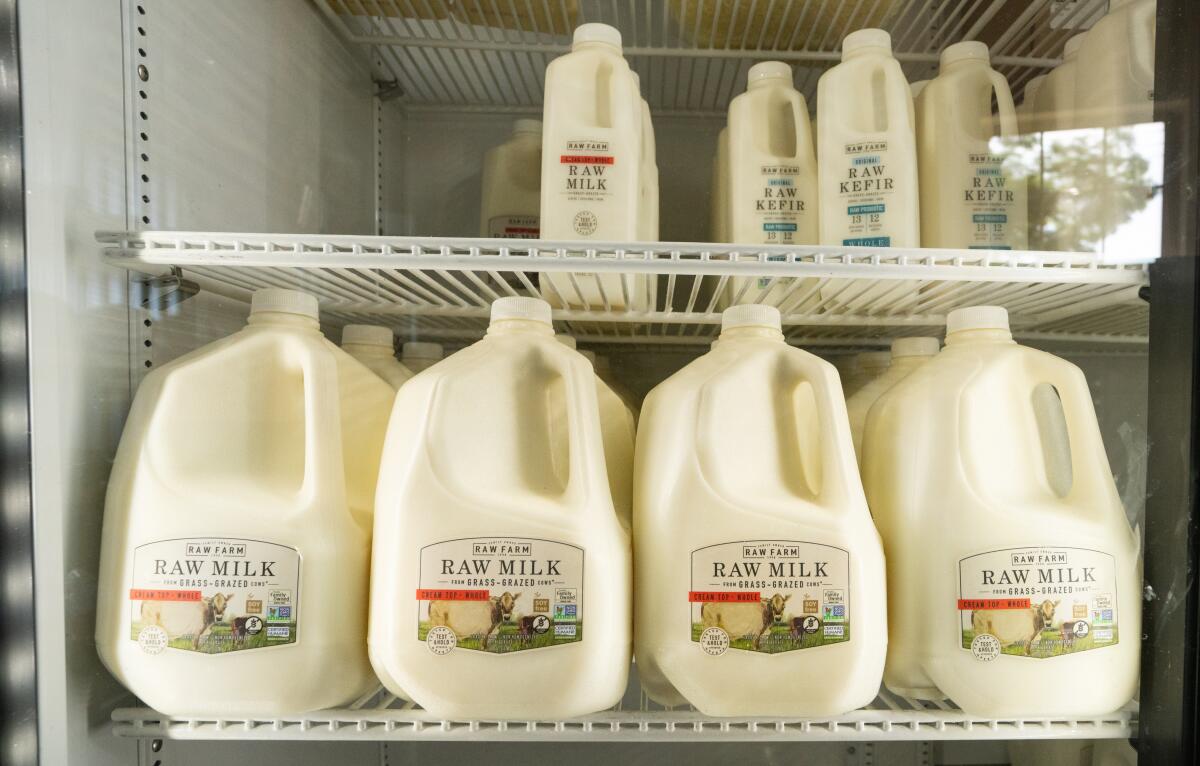
The Los Angeles County Department of Public Health said Thursday that it is investigating two possible cases of H5N1 bird flu in cats that consumed recalled raw milk from Raw Farm LLC.
The animals have died.
The two cats, who lived indoors in the same household, reportedly consumed raw milk that was linked to the statewide recall of raw milk and cream products. After lapping up the product, the animals developed symptoms that included a lack of appetite, fever and signs of neurological problems.
“I think this is just the tip of the iceberg,” said Jane Sykes, professor of medicine and epidemiology at UC Davis School of Veterinary Medicine. “They can’t be isolated. I’m sure we’ll see more.”
Both animals died after symptoms severely worsened. And both animals tested positive for influenza A, a rare finding for cats.
Influenza A viruses include most human seasonal flu viruses as well bird flu variants, including H5N1.
County health authorities are considering the animals “presumptive” H5N1 bird flu cases. They have sought confirmatory testing.
Health officials said in a statement that people who had direct contact with the cats are now being monitored for symptoms and have been offered Tamiflu or other antiviral medications.
There have been no associated human infections with these cats.
“The risk of H5 bird flu remains low in Los Angeles County, but this suspected case of the virus in a pet cat that consumed raw milk is a reminder that consuming raw dairy products can lead to severe illness in cats,” Barbara Ferrer, the director of the Los Angeles County Department of Public Health, said in a statement.
She said the health department is encouraging residents and their pets to “avoid raw dairy and undercooked meat products, limit contact with sick or dead animals, report sick or dead birds and keep pets or poultry away from wild animals and birds.”
Sharon Balter, director of the Division of Communicable Disease Control and Prevention, told The Times in an interview that the cats’ symptoms appeared between eight and 10 days after consuming the raw milk — which was not tested, but for which the lot numbers aligned with those recalled.
She said the cats also presented signs of liver damage, with yellowing of the eyes and gums.
She said it was the same veterinarian who treated the two cats and reported the illness to the county. She said both animals were orally swabbed — apparently not an easy feat with a cat, as the swab goes “in deep.” And one of the cats’ bodies has been sent out for further investigation. She was not sure about the particulars of the other.
Balter said the county has been and will continue to conduct outreach to veterinarians to make sure they are aware of the outbreak and know what symptoms to look for.
It is unclear how many cats have died since H5N1 began circulating in dairy cows earlier this year. They are extremely susceptible to the virus, however, and dead barn cats are considered an early biological warning that a dairy has been affected by the virus.
“I am really worried about cats and this virus,” said Sykes, the UC Davis veterinarian. “I really think there should be more concern regarding domestic cats, especially in light of cats having mortality rates like between 50% and 67%” when infected by H5N1.
“It’s really high. Cats are really susceptible to this virus and there is this incredible trend for feeding raw food, diets and raw products. So it’s just waiting to happen,” she said.
At one Texas dairy farm this spring, half of a cluster of 24 barn cats died after drinking infected raw milk.
Sykes also noted a 2023 outbreak in South Korea, in which shelter cats had been fed pet food made with H5N1-infected raw duck. In one shelter, 38 of 40 cats died after eating the contaminated food.
Last year, the World Health Organization reported sporadic deaths of cats throughout areas known to be infected with H5N1 bird flu, including at one location in Poland, where a cluster of 46 died; 29 cats were found to be positive for the bird flu virus.
Larger cats, including captive lions, tigers and panthers, have also died as a result of eating meat contaminated with bird flu. So, too, have wild California bobcats and mountain lions.
Symptoms of H5N1 infection in cats include labored breathing, bloody diarrhea and neurological abnormalities — loss of motor control, seizures, depressed mental state, stiff body movements, blindness, circling, copious eye and nose discharge and coma — with rapid deterioration and death in some cases.
Outdoor cats can also be exposed to bird flu by consuming infected birds or other animals and by being in environments contaminated with the virus, or by consuming unpasteurized milk from infected cows.
Sykes said cats should be kept indoors, or at the very least, in a “catio” (an outdoor enclosure for cats) — but even those, she added, have the potential for exposure to infected birds.
The L.A. County statement noted that cats have transmitted other influenza strains to humans in the past, “but there have been no known cases to date of H5 bird flu transmitted from cats to humans as part of this nationwide H5 bird flu outbreak.”
Last month’s raw milk recall applied only to raw whole milk and cream products — not to cheese, kefir or pet food products made with raw milk, including “raw milk pet food topper” and “pet food kefir.”
Health officials are urging people to avoid those and other raw food pet products as well.
Balter also asked people to call their veterinarians before going to the clinic if they suspect bird flu. Doing so will allow clinic staff to make preparations allowing them to keep pets separated.